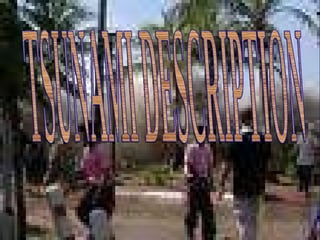
Tsunami Description
- 2. WHAT?
- 3. Tsunami "Wave Train" Many people have the mistaken belief that tsunamis are single waves. They are not. Instead tsunamis are "wave trains" consisting of multiple waves. The chart below is a tidal gauge record from Onagawa, Japan beginning at the time of the 1960 Chile earthquake. Time is plotted along the horizontal axis and water level is plotted on the vertical axis. Note the normal rise and fall of the ocean surface, caused by tides, during the early part of this record. Then recorded are a few waves a little larger than normal followed by several much larger waves. In many tsunami events the shoreline is pounded by repeated large waves.
- 6. WHAT CAUSE? Most tsunamis are caused by earthquakes generated in a seduction zone, an area where an oceanic plate is being forced down into the mantle by plate tectonic forces. The friction between the sub ducting plate and the overriding plate is enormous. This friction prevents a slow and steady rate of seduction and instead the two plates become "stuck". Subduction Zones are Potential Tsunami Locations
- 7. WHAT CAUSE? As the stuck plate continues to descend into the mantle the motion causes a slow distortion of the overriding plage. The result is an accumulation of energy very similar to the energy stored in a compressed spring. Energy can accumulate in the overriding plate over a long period of time - decades or even centuries. Accumulated Seismic Energy
- 8. WHERE? Tsunamis occur most frequently in the Pacific Ocean , but are a global phenomenon; they are possible wherever large bodies of water are found, including inland lakes, where they can be caused by landslides. Japan is a nation with the most recorded tsunamis in the world. The earliest recorded disaster being that of the 684 A.D.
- 9. Tsunami is one of the earth’s disaster. It was a Japanese word meaning “harbor wave,” used as the scientific term for a class of abnormal sea wave that can cause catastrophic damage when it hits a coastline. Tsunamis can be generated by an undersea earthquake, an undersea landslide, the eruption of an undersea volcano, or by the force of an asteroid crashing into the ocean.